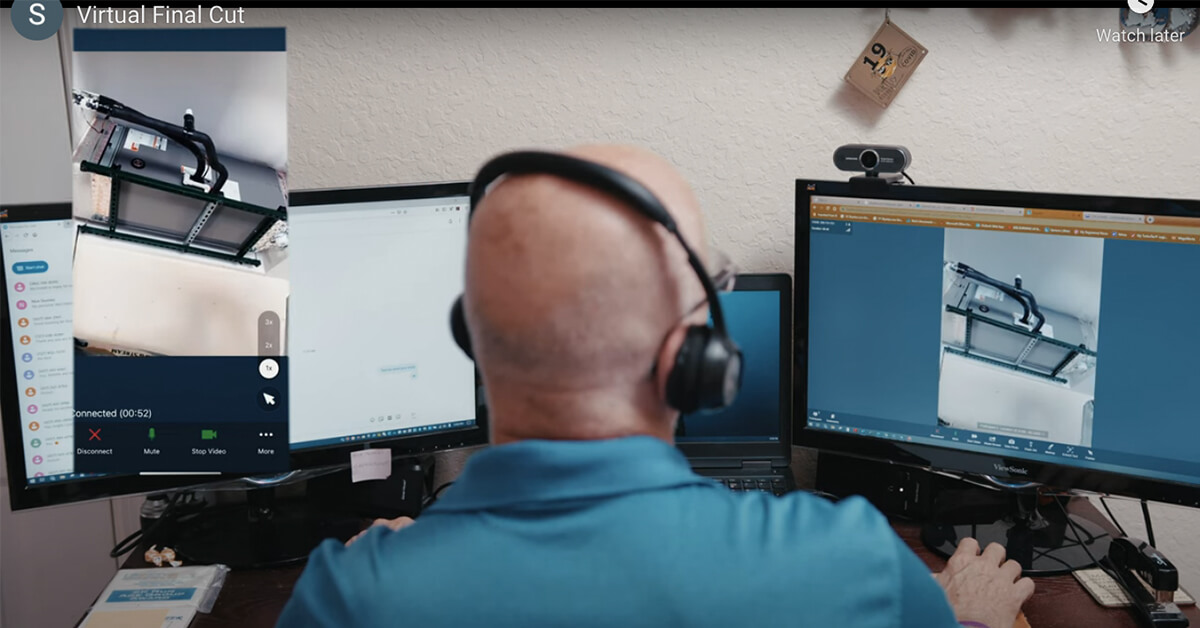9 Critical Components of the Top Remote Inspection Tools
Performing remote inspections requires the right tools to compensate for what the inspector normally does and sees in person.
Being able to observe, read, and record information and data is critical to an audit. And when it comes to communication, the lack of in-person body language makes remote communication more difficult.
The right remote video inspection tool can mitigate those challenges, making your remote audit as good as—if not better than—an in-person audit.
If you’re building a tool stack to make remote inspections a feasible reality, there are a few critical components that the tech stack must include.
Remote Inspection Tools: 9 Critical Components
In many cases, remote technologies overlap in functionality. Some implement similar features in different ways, for the better or worse. It’s essential to explore all your options before adding a tool to your tech stack.
Related Read: Advantages of Remote Video Inspections over Virtual Inspections
Putting each tool through all the paces and use cases you expect it to handle is the only way to know whether or not it will perform in the real world. When considering your options, we recommend using these components as a benchmark to help cull the tools that won’t fit and reveal the ones that do the best for your particular use cases.
The 9 Tools You Need In Your Remote Inspection Toolkit:
- Intuitive User Interface
- Frictionless Inspection Sessions
- Mobile Video Capability
- Augmented Reality Functionality
- Live Location Tracking
- Documenting & Reporting
- Artificial Intelligence
- Group Enablement
- Bandwidth Optimization
1. Intuitive User Interface
In many industries, inspections are highly complex. Conducting them remotely adds a new twist to the process. The last thing you need is to choose a tool that adds more layers of complexity on top of the already difficult job.
If the tool you’re considering has a cluttered and complex user interface, your inspectors will need in-depth training to get up to speed. Even then, adoption will be slow, and mastery will take some time. You don’t want inspectors confused by their tools in the middle of a vital inspection.
You also don’t want your customers to be frustrated and annoyed with complex software on their end, either. If the tool isn’t intuitive and easy to figure out, it’s probably not a good fit.
Steve Jobs was famous for saying of Apple products, “it just works!”
Having that experience with your remote inspection tools is a great first step into having higher adoption rates with your inspectors.
2. Frictionless Inspection Sessions
Does the inspection tool require software download and installs? If so, you run the risk of your inspector or customer running into compatibility issues or other technical problems. When the technology causes friction because of “technical difficulties,” it will impede or delay the audit.
The best way to combat software and compatibility issues is to explore cloud-based tools rather than ones that must run natively on machines. This makes compatibility virtually universal and makes software downloads and configurations a thing of the past. Not only that, but it’s much faster to get up and running with your inspection counterparts.
Starting the session should be as easy as clicking a link.
3. Mobile Video Capability
Visibility and communication are two of the main reasons remote inspections are complex. Using a mobile device’s video capability can provide the inspector an “eye in the room.”
Getting personal observations of the object of inspection rather than relying on verbal descriptions is a huge benefit. And being mobile-enabled means being able to move around easily and get a visual on hard-to-reach areas even if the equipment is off-premises in the field.
Read More: How to Conduct an On-Site Remote Video Inspection for Commercial and Residential Buildings
4. Augmented Reality Functionality
This component goes hand in hand with mobile video capability. Communication is difficult over the phone and even over meeting software. There are always awkward moments when the inspector asks a question, but the counterpart doesn’t understand exactly what the inspector asks.
With augmented reality, the inspector can add visual cues along with verbal instructions. Being able to say, “show me this,” and point to it through the mobile device’s camera is a lot easier than trying to verbally describe the “thing” you need to inspect closer.
Real-time annotation can also provide valuable visual assistance to get questions answered faster.
5. Live Location Tracking
The best digital inspection tools make it possible to revisit the inspection in interesting and powerful ways. For example, Blitzz includes a location tracking feature that provides the inspector a map of the inspection area and spatial tracking of the route taken by the person with the phone or tablet. The images and videos taken show superimposed over the map via their geolocated coordinates.
6. Documenting & Reporting
Inspectors spend a lot of time capturing photos and notes when they are on-site. Then, they must collate the videos, photos, and notes into their report. Remote video inspection tools should do this all on the fly, making the report ready in just a few moments after the inspection is completed.
Automatic Date, Time, and Geo-Tagging Images
The remote inspection tool of choice shouldn’t just capture images—they should capture valuable meta information as well. With Blitzz, every image capture is automatically time and date stamped and tagged with the geolocation, accurate within 10 feet.
7. Artificial Intelligence
Machine learning and artificial intelligence make manual tasks much faster. Machine-assisted work can make inspectors more efficient, especially when it comes to communicating text and numbers.
With tools like Blitzz, capturing text and numbers is as easy as clicking a button. Compared to trying to communicate digits and letters verbally, capturing and copy/pasting is much faster and more accurate.
8. Group Enablement
Sometimes, you need to loop more people into your discussion. In some cases, it can be someone standing in the same room as the customer. In other cases, other experts or supervisors need to join the session remotely to answer questions or give guidance.
The best remote inspection tools will allow for adding critical parties to the remote sessions easily.
Being able to add silent observers is also an excellent feature for training. If supervisors can silently observe a call, they can get valuable insights for feedback. New trainees can also gain practical experience silently observing the calls of seasoned inspectors.
9. Bandwidth Optimization
This is a practical function of remote inspection tools but one of critical importance. Relying on video functionality for remote inspections means having the necessary bandwidth to keep the call quality high. Bandwidth will become an issue when the signal is low or when the inspection takes place in remote areas with spotty cellular service.
The best video-based tools will have the ability to compensate (within reason) for slower internet speeds without impairing the inspector's abilities to complete their work.
Build the Right Remote Inspection Toolkit
There are a lot of benefits of remote video inspections. But to do it right, you will need to have the right tools in place. We always recommend putting every potential tool to the test. If the tool deserves to be in your arsenal, it should be proven to do the job and do it well.
If you’re comparing multiple tools for a single use case, there are a few things to consider:
- Which tools have all the must-have features for your particular use case?
- Are the tools easy to use for both parties involved in the inspection?
- Are the tools reliable to work in most conditions without compatibility issues?
- Do they add value beyond the examination itself?
We’ve built Blitzz Inspect to be an essential tool in completing remote inspections quickly. One of our clients, a prominent tech manufacturing company, cut travel costs by 80% simply by using Blitzz to conduct remote inspections. Other clients report the same, including a 3-5X increase in productivity as their team can complete more inspections in less time.
If you want to give Blitzz a try, you can get instant access here.
.png?width=120&height=55&name=Blitzz-Logo-right%20white%20eyes%20-%20not%20transparent%20(3).png)


.jpg)
